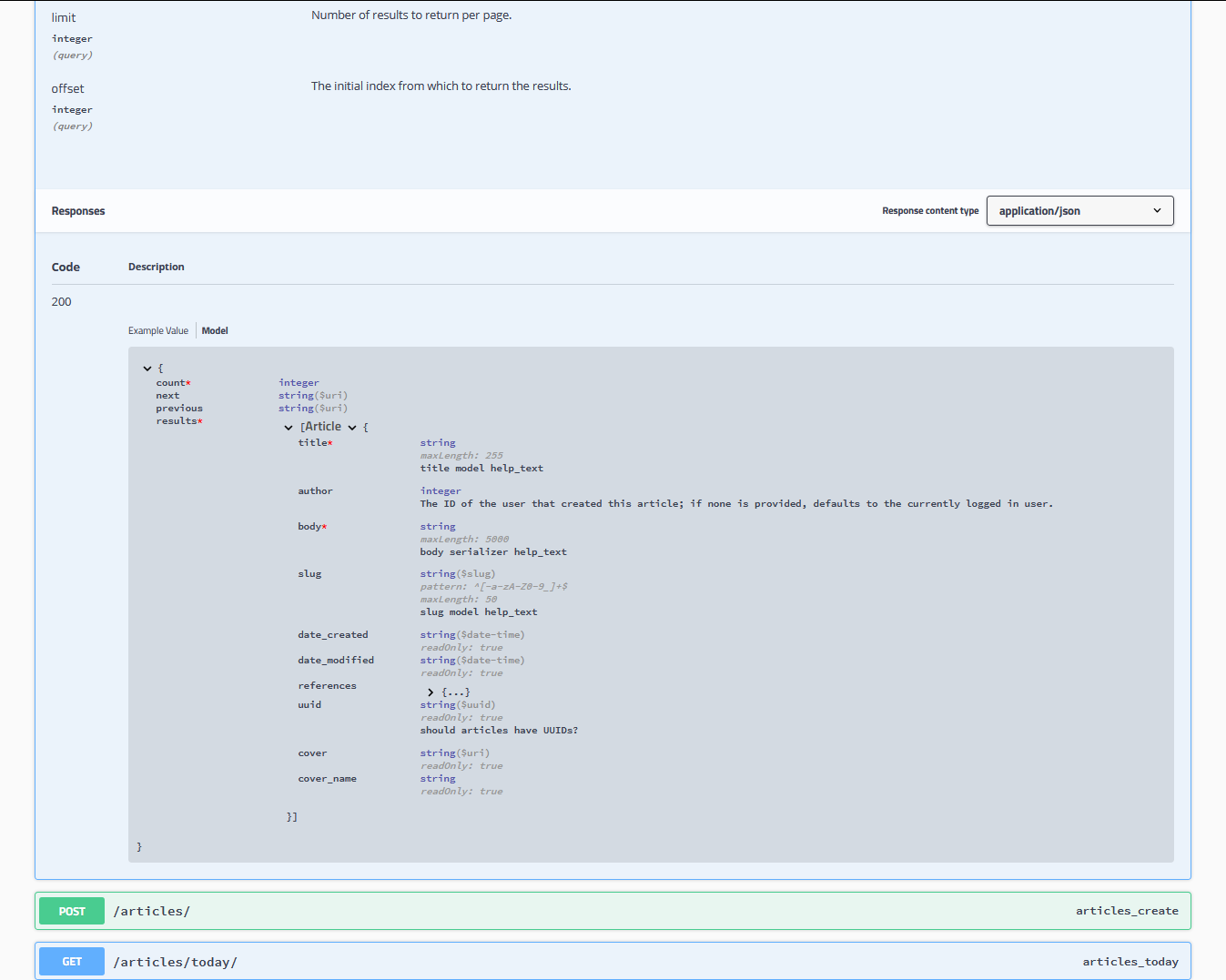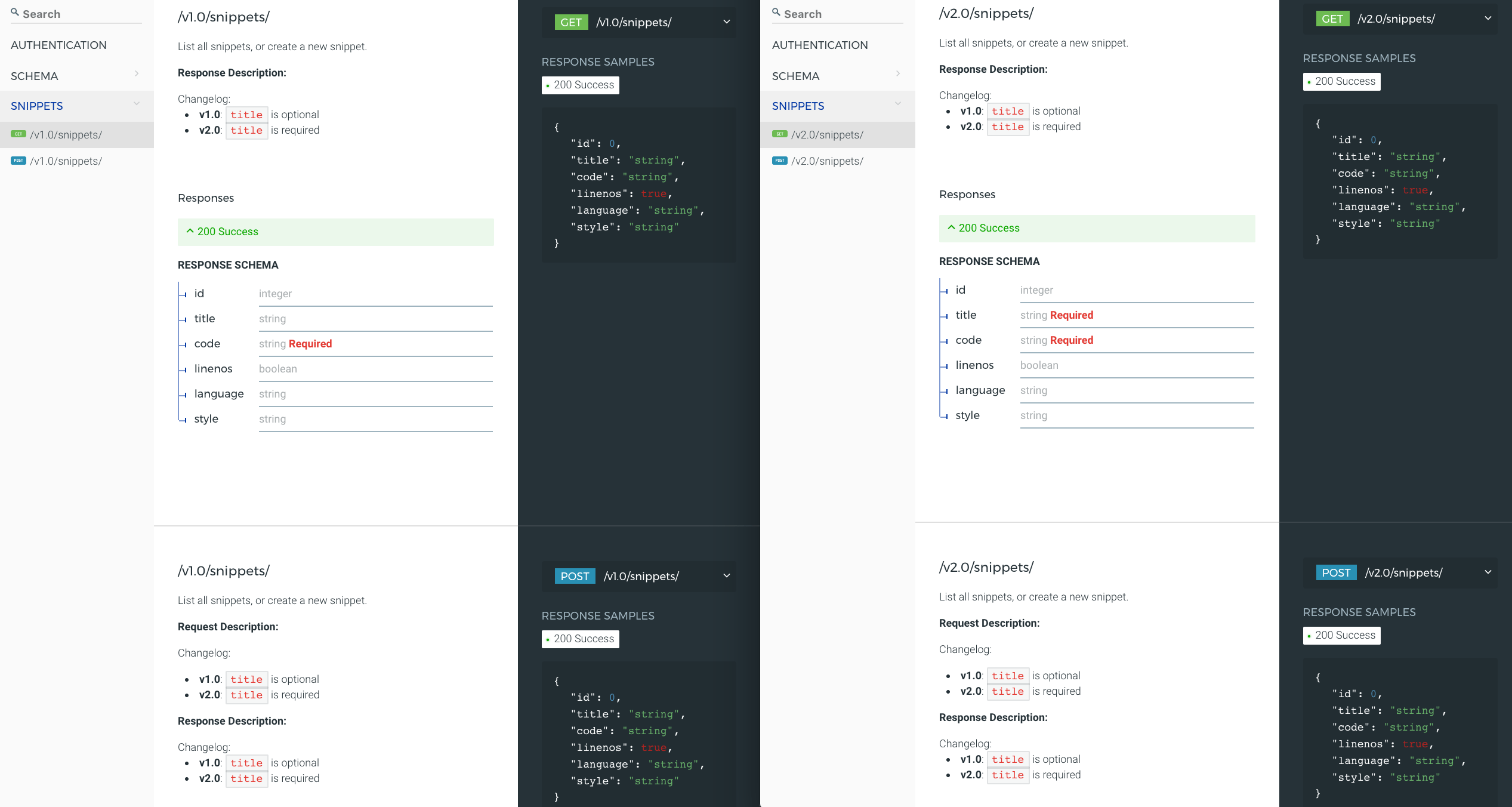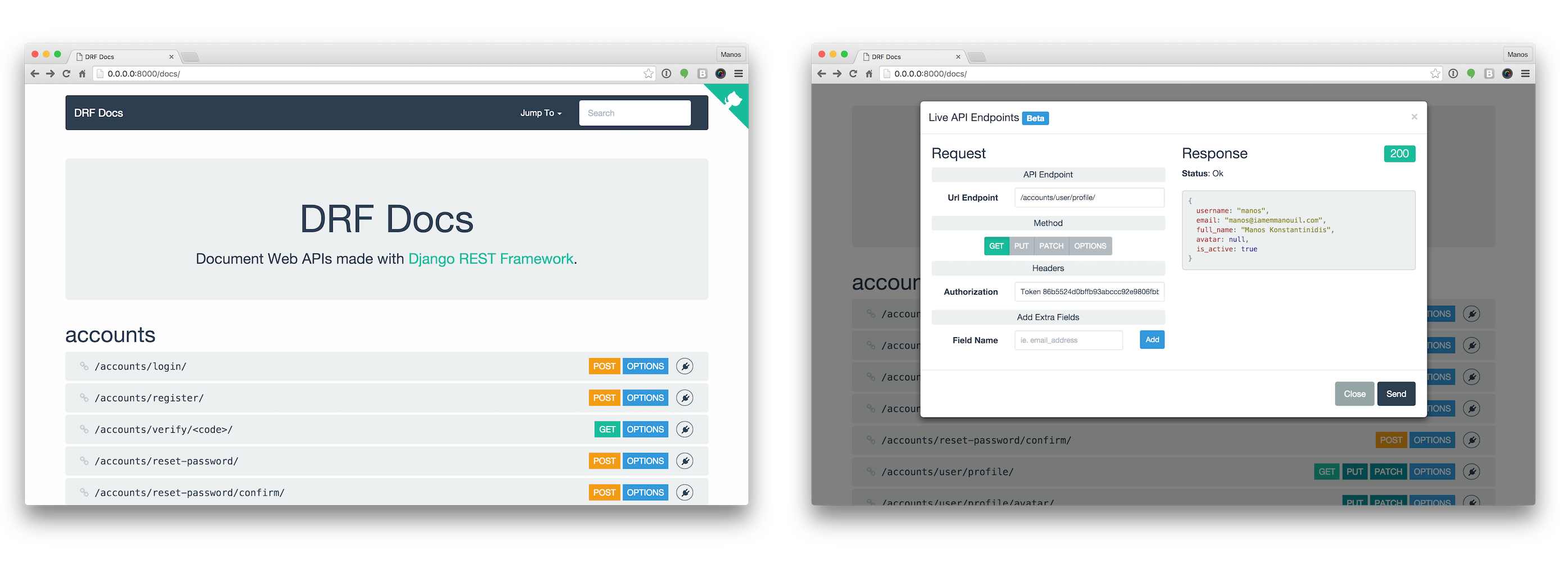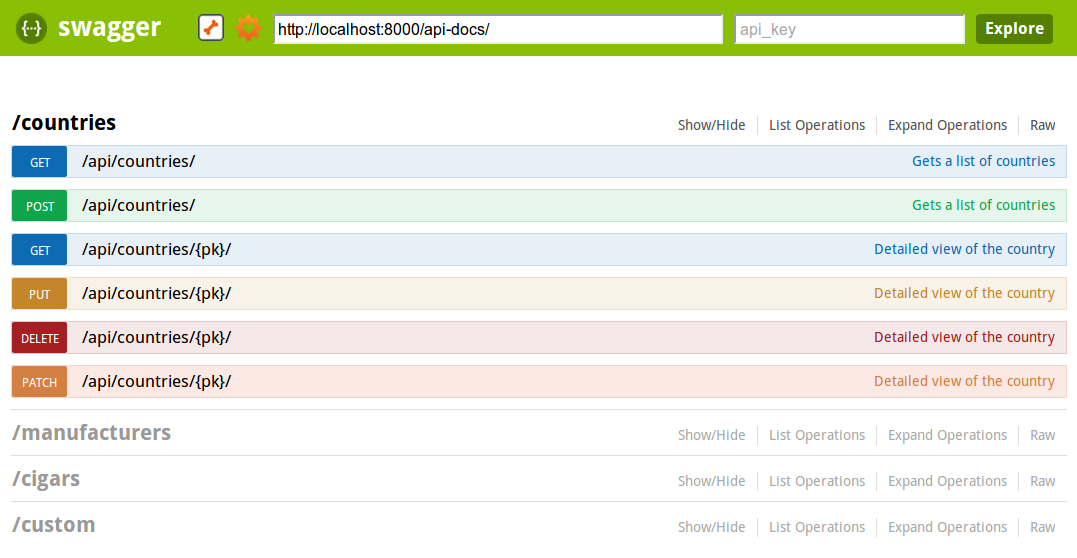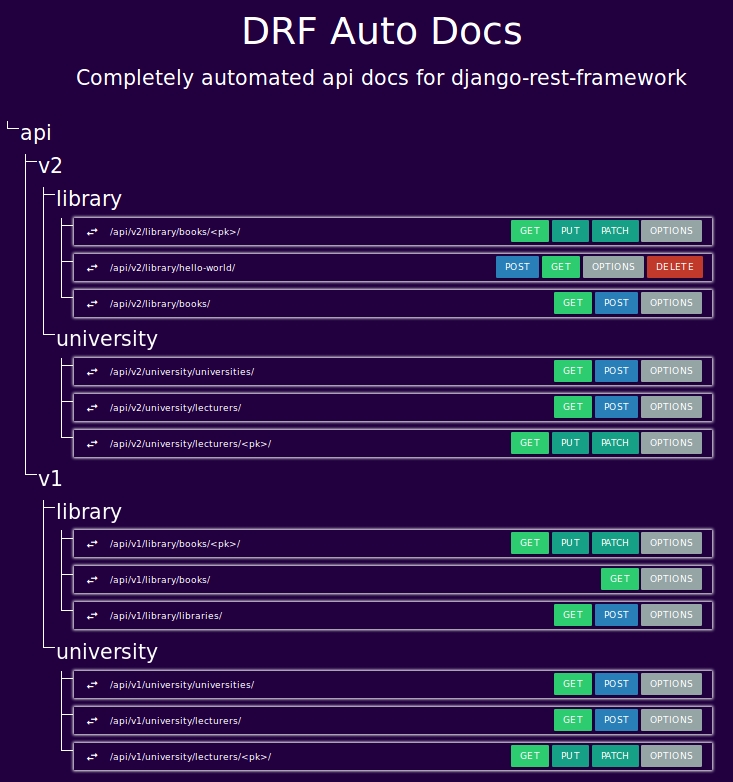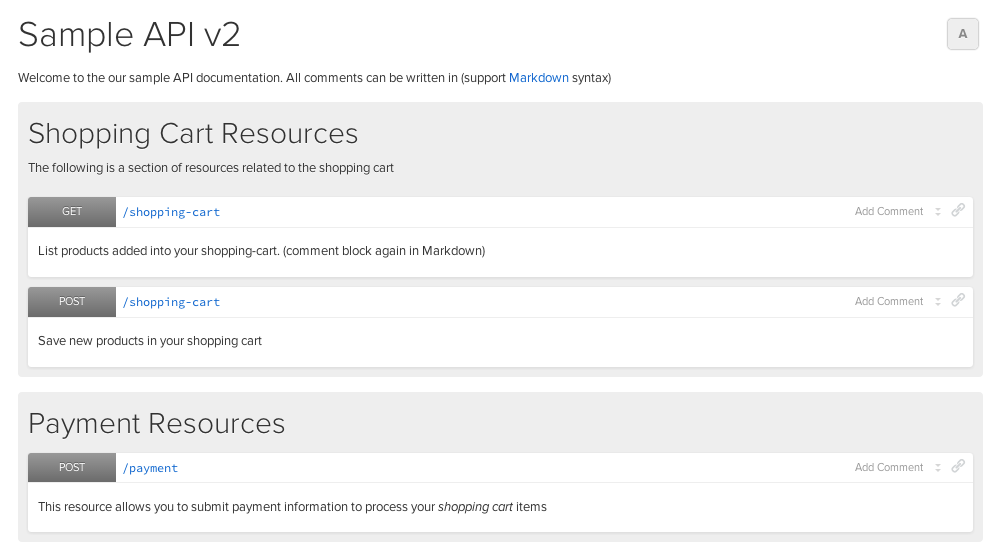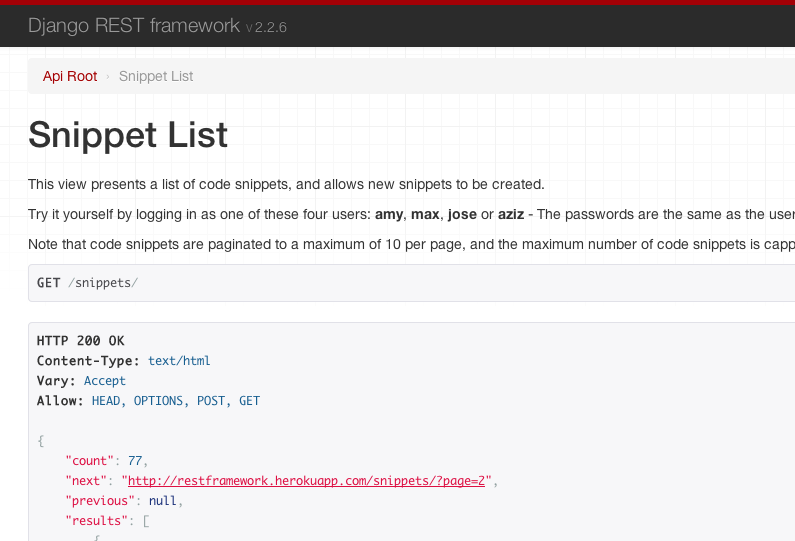* added ability to add sections to custom action documentation * added tests to cover docs sections in custom actions * added method specific docs test for action mapping * added docs for custom action documentation
17 KiB
Documenting your API
A REST API should spend almost all of its descriptive effort in defining the media type(s) used for representing resources and driving application state.
— Roy Fielding, REST APIs must be hypertext driven
REST framework provides built-in support for API documentation. There are also a number of great third-party documentation tools available.
Built-in API documentation
The built-in API documentation includes:
- Documentation of API endpoints.
- Automatically generated code samples for each of the available API client libraries.
- Support for API interaction.
Installation
The coreapi library is required as a dependency for the API docs. Make sure
to install the latest version. The pygments and markdown libraries
are optional but recommended.
To install the API documentation, you'll need to include it in your project's URLconf:
from rest_framework.documentation import include_docs_urls
urlpatterns = [
...
url(r'^docs/', include_docs_urls(title='My API title'))
]
This will include two different views:
/docs/- The documentation page itself./docs/schema.js- A JavaScript resource that exposes the API schema.
Note: By default include_docs_urls configures the underlying SchemaView to generate public schemas.
This means that views will not be instantiated with a request instance. i.e. Inside the view self.request will be None.
To be compatible with this behaviour, methods (such as get_serializer or get_serializer_class etc.) which inspect self.request or, particularly, self.request.user may need to be adjusted to handle this case.
You may ensure views are given a request instance by calling include_docs_urls with public=False:
from rest_framework.documentation import include_docs_urls
urlpatterns = [
...
# Generate schema with valid `request` instance:
url(r'^docs/', include_docs_urls(title='My API title', public=False))
]
Documenting your views
You can document your views by including docstrings that describe each of the available actions. For example:
class UserList(generics.ListAPIView):
"""
Return a list of all the existing users.
"""
If a view supports multiple methods, you should split your documentation using method: style delimiters.
class UserList(generics.ListCreateAPIView):
"""
get:
Return a list of all the existing users.
post:
Create a new user instance.
"""
When using viewsets, you should use the relevant action names as delimiters.
class UserViewSet(viewsets.ModelViewSet):
"""
retrieve:
Return the given user.
list:
Return a list of all the existing users.
create:
Create a new user instance.
"""
Custom actions on viewsets can also be documented in a similar way using the method names as delimiters or by attaching the documentation to action mapping methods.
class UserViewSet(viewsets.ModelViewset):
...
@action(detail=False, methods=['get', 'post'])
def some_action(self, request, *args, **kwargs):
"""
get:
A description of the get method on the custom action.
post:
A description of the post method on the custom action.
"""
@some_action.mapping.put
def put_some_action():
"""
A description of the put method on the custom action.
"""
documentation API Reference
The rest_framework.documentation module provides three helper functions to help configure the interactive API documentation, include_docs_urls (usage shown above), get_docs_view and get_schemajs_view.
include_docs_urls employs get_docs_view and get_schemajs_view to generate the url patterns for the documentation page and JavaScript resource that exposes the API schema respectively. They expose the following options for customisation. (get_docs_view and get_schemajs_view ultimately call rest_frameworks.schemas.get_schema_view(), see the Schemas docs for more options there.)
include_docs_urls
title: DefaultNone. May be used to provide a descriptive title for the schema definition.description: DefaultNone. May be used to provide a description for the schema definition.schema_url: DefaultNone. May be used to pass a canonical base URL for the schema.public: DefaultTrue. Should the schema be considered public? IfTrueschema is generated without arequestinstance being passed to views.patterns: DefaultNone. A list of URLs to inspect when generating the schema. IfNoneproject's URL conf will be used.generator_class: Defaultrest_framework.schemas.SchemaGenerator. May be used to specify aSchemaGeneratorsubclass to be passed to theSchemaView.authentication_classes: Defaultapi_settings.DEFAULT_AUTHENTICATION_CLASSES. May be used to pass custom authentication classes to theSchemaView.permission_classes: Defaultapi_settings.DEFAULT_PERMISSION_CLASSESMay be used to pass custom permission classes to theSchemaView.renderer_classes: DefaultNone. May be used to pass custom renderer classes to theSchemaView.
get_docs_view
title: DefaultNone. May be used to provide a descriptive title for the schema definition.description: DefaultNone. May be used to provide a description for the schema definition.schema_url: DefaultNone. May be used to pass a canonical base URL for the schema.public: DefaultTrue. IfTrueschema is generated without arequestinstance being passed to views.patterns: DefaultNone. A list of URLs to inspect when generating the schema. IfNoneproject's URL conf will be used.generator_class: Defaultrest_framework.schemas.SchemaGenerator. May be used to specify aSchemaGeneratorsubclass to be passed to theSchemaView.authentication_classes: Defaultapi_settings.DEFAULT_AUTHENTICATION_CLASSES. May be used to pass custom authentication classes to theSchemaView.permission_classes: Defaultapi_settings.DEFAULT_PERMISSION_CLASSES. May be used to pass custom permission classes to theSchemaView.renderer_classes: DefaultNone. May be used to pass custom renderer classes to theSchemaView. IfNonetheSchemaViewwill be configured withDocumentationRendererandCoreJSONRendererrenderers, corresponding to the (default)htmlandcorejsonformats.
get_schemajs_view
title: DefaultNone. May be used to provide a descriptive title for the schema definition.description: DefaultNone. May be used to provide a description for the schema definition.schema_url: DefaultNone. May be used to pass a canonical base URL for the schema.public: DefaultTrue. IfTrueschema is generated without arequestinstance being passed to views.patterns: DefaultNone. A list of URLs to inspect when generating the schema. IfNoneproject's URL conf will be used.generator_class: Defaultrest_framework.schemas.SchemaGenerator. May be used to specify aSchemaGeneratorsubclass to be passed to theSchemaView.authentication_classes: Defaultapi_settings.DEFAULT_AUTHENTICATION_CLASSES. May be used to pass custom authentication classes to theSchemaView.permission_classes: Defaultapi_settings.DEFAULT_PERMISSION_CLASSESMay be used to pass custom permission classes to theSchemaView.
Customising code samples
The built-in API documentation includes automatically generated code samples for each of the available API client libraries.
You may customise these samples by subclassing DocumentationRenderer, setting
languages to the list of languages you wish to support:
from rest_framework.renderers import DocumentationRenderer
class CustomRenderer(DocumentationRenderer):
languages = ['ruby', 'go']
For each language you need to provide an intro template, detailing installation instructions and such,
plus a generic template for making API requests, that can be filled with individual request details.
See the templates for the bundled languages for examples.
Third party packages
There are a number of mature third-party packages for providing API documentation.
drf-yasg - Yet Another Swagger Generator
drf-yasg is a Swagger generation tool implemented without using the schema generation provided by Django Rest Framework.
It aims to implement as much of the OpenAPI specification as possible - nested schemas, named models,
response bodies, enum/pattern/min/max validators, form parameters, etc. - and to generate documents usable with code
generation tools like swagger-codegen.
This also translates into a very useful interactive documentation viewer in the form of swagger-ui:
DRF OpenAPI
DRF OpenAPI bridges the gap between OpenAPI specification and tool chain with the schema exposed out-of-the-box by Django Rest Framework. Its goals are:
- To be dropped into any existing DRF project without any code change necessary.
- Provide clear disctinction between request schema and response schema.
- Provide a versioning mechanism for each schema. Support defining schema by version range syntax, e.g. >1.0, <=2.0
- Support multiple response codes, not just 200
- All this information should be bound to view methods, not view classes.
It also tries to stay current with the maturing schema generation mechanism provided by DRF.
DRF Docs
DRF Docs allows you to document Web APIs made with Django REST Framework and it is authored by Emmanouil Konstantinidis. It's made to work out of the box and its setup should not take more than a couple of minutes. Complete documentation can be found on the website while there is also a demo available for people to see what it looks like. Live API Endpoints allow you to utilize the endpoints from within the documentation in a neat way.
Features include customizing the template with your branding, settings for hiding the docs depending on the environment and more.
Both this package and Django REST Swagger are fully documented, well supported, and come highly recommended.
Django REST Swagger
Marc Gibbons' Django REST Swagger integrates REST framework with the Swagger API documentation tool. The package produces well presented API documentation, and includes interactive tools for testing API endpoints.
Django REST Swagger supports REST framework versions 2.3 and above.
Mark is also the author of the REST Framework Docs package which offers clean, simple autogenerated documentation for your API but is deprecated and has moved to Django REST Swagger.
Both this package and DRF docs are fully documented, well supported, and come highly recommended.
DRF AutoDocs
Oleksander Mashianovs' DRF Auto Docs automated api renderer.
Collects almost all the code you written into documentation effortlessly.
Supports:
- functional view docs
- tree-like structure
- Docstrings:
- markdown
- preserve space & newlines
- formatting with nice syntax
- Fields:
- choices rendering
- help_text (to specify SerializerMethodField output, etc)
- smart read_only/required rendering
- Endpoint properties:
- filter_backends
- authentication_classes
- permission_classes
- extra url params(GET params)
Apiary
There are various other online tools and services for providing API documentation. One notable service is Apiary. With Apiary, you describe your API using a simple markdown-like syntax. The generated documentation includes API interaction, a mock server for testing & prototyping, and various other tools.
Self describing APIs
The browsable API that REST framework provides makes it possible for your API to be entirely self describing. The documentation for each API endpoint can be provided simply by visiting the URL in your browser.
Setting the title
The title that is used in the browsable API is generated from the view class name or function name. Any trailing View or ViewSet suffix is stripped, and the string is whitespace separated on uppercase/lowercase boundaries or underscores.
For example, the view UserListView, will be named User List when presented in the browsable API.
When working with viewsets, an appropriate suffix is appended to each generated view. For example, the view set UserViewSet will generate views named User List and User Instance.
Setting the description
The description in the browsable API is generated from the docstring of the view or viewset.
If the python markdown library is installed, then markdown syntax may be used in the docstring, and will be converted to HTML in the browsable API. For example:
class AccountListView(views.APIView):
"""
Returns a list of all **active** accounts in the system.
For more details on how accounts are activated please [see here][ref].
[ref]: http://example.com/activating-accounts
"""
Note that when using viewsets the basic docstring is used for all generated views. To provide descriptions for each view, such as for the the list and retrieve views, use docstring sections as described in Schemas as documentation: Examples.
The OPTIONS method
REST framework APIs also support programmatically accessible descriptions, using the OPTIONS HTTP method. A view will respond to an OPTIONS request with metadata including the name, description, and the various media types it accepts and responds with.
When using the generic views, any OPTIONS requests will additionally respond with metadata regarding any POST or PUT actions available, describing which fields are on the serializer.
You can modify the response behavior to OPTIONS requests by overriding the options view method and/or by providing a custom Metadata class. For example:
def options(self, request, *args, **kwargs):
"""
Don't include the view description in OPTIONS responses.
"""
meta = self.metadata_class()
data = meta.determine_metadata(request, self)
data.pop('description')
return data
See the Metadata docs for more details.
The hypermedia approach
To be fully RESTful an API should present its available actions as hypermedia controls in the responses that it sends.
In this approach, rather than documenting the available API endpoints up front, the description instead concentrates on the media types that are used. The available actions that may be taken on any given URL are not strictly fixed, but are instead made available by the presence of link and form controls in the returned document.
To implement a hypermedia API you'll need to decide on an appropriate media type for the API, and implement a custom renderer and parser for that media type. The REST, Hypermedia & HATEOAS section of the documentation includes pointers to background reading, as well as links to various hypermedia formats.
